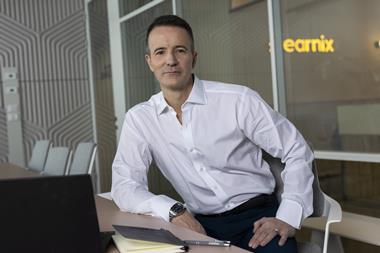With the Covid-19 pandemic accelerating both customer and staff comfort in using digital communications and processes, insurer and customer engagement is expected to go up a notch in 2021, predicts UK claims boss
Insurers’ engagement with their customers will continue to evolve in 2021 thanks to an increasing adoption and understanding of technology, says Ageas UK’s claims director Robin Challand.
Speaking exclusively to Insurance Times, Challand believes that how insurers “engage with their customers in a different way” is a key trend for 2021, centred around a Covid-accelerated acceptance from both policyholders and insurance staff in using digital communications.
“The greater use of digital interaction and [artificial intelligence] to continue to drive better engagement between the customer and the insurer, and then the insurer and their partners in the supply chain, as an example, is going to continue to evolve,” he says.
“Most people working at home are very familiar with video conferencing and software, which means that some of those engagement tools that we have already been using for some time, we’ve seen a take up in engagement in those tools because people are more comfortable with it.
“Interestingly, not just our customers but also the people in our teams who are contacting and speaking with our customers every day.”

Linked to this, Challand thinks there “will be a step change in the digital engagement with claims, beyond the initial notification journey”, especially as there are “a number of startups in the market [that] are thinking about this”.
From an Ageas perspective, technology is already informing its home claims process thanks to “a video engagement tool which allows us to connect with the customer and see what the customer is seeing in real time. They can show us the area of damage, wherever it might be, and we’re able to – in real time – discuss and talk to them about that”.
The insurer then uses a tool called Symbility to “assess the potential value of that claim”. Furthermore, “on the motor side of things, we use our AI app to assess vehicle damage,” Challand continues.
Not only has this tech-centric approach stripped claims processing times from two to three days down to hours, but Challand believes it also provides a more transparent engagement with customers because Ageas is able to come to claims decisions much quicker.
“What we’ve found is that during lockdown, customers were even keener to engage in that technology then they were pre-lockdown. We had some really good response rates pre-lockdown, but it’s notably improved,” Challand adds.
Off the back of this, Ageas plans to “build up a broader range of tools that help our customers and we’re thinking about that as we’re moving into 2021”.
In terms of other technology trends that could come into play for 2021, Challand says: “I think AI broadening beyond motor, where it tends to be focused at the moment, will evolve – whether that’s next year or a couple of years down the line, I’m not so sure.
“Behind the scenes within insurers, around the intelligent robotic process automation and those kinds of things, so that evolution of things that we see today I think will just pick up pace.
“One of the things that Covid has shown is that actually you can change at a much faster pace than perhaps a number of industries, not just insurers, but a number of industries thought they could.
“I think we’ll see that cadence of change pick up [this year] across digital and AI and those kinds of things.”
CV
- January 2018, took up current position as claims director at Ageas UK.
- November 2014 to December 2017, director of IT, Ageas UK.
- April 2013 to November 2014, head of business integration, Ageas UK.
- October 2010, started at Ageas as head of operations.
Pandemic pressed claims
Also for 2021, Challand thinks that “the nature and type of claims that we might see” will continue to be influenced by the coronavirus pandemic. For example, “you might continue to see trends around accidental damage, you might continue to see awareness of things like escape of water”.
Regarding motor insurance, Challand says: “In terms of the traffic on the roads, I think it will be very interesting to see how the 7am to 10am and 4pm to 7pm commuting windows differ [and] people’s approach to transport.
“More people working from home, but perhaps less people comfortable in using public transport. Do they net each other off? Do they actually see different demands? In the motor space, I think that despite all of the changes and more people perhaps walking or using cycling as a means of transport, I think the numbers will increase in 2021. Whether they’ll increase to the pre-Covid norms, I suspect not.”
Challenges ahead
Challand predicts a number of bumps in the road that could impact the claims environment this year.
Firstly, the “unknown impact of continued lockdown and the impact that’s having on businesses and the supply chain”, especially as the start of the year heralded the arrival of yet another national lockdown in the UK.
This, in turn, links to “the challenges that working from home brings”.
“It changes the way of working, it changes leadership behaviours, it changes that learning through osmosis that you get from being in an office, it changes the nature of engagement,” Challand explains.
Furthermore, Challand says that vehicle technology will need to be considered from a claims perspective, while Brexit’s impact on supply chains is also something to watch.
“There’s the uncertainty that Brexit still provides around [the] supply chain, and not just in terms of vehicle repair but just generally supply chains in terms of goods and services and parts. That could be from a replacement television in a property claim through to the supply of new vehicles,” he says.
Aside from Covid-19, what else could impact the claims sector this year?
Challand says: “At the beginning of this year, we were thinking around the Litigant in Person (LiP) portal, which has been deferred to April, so you’re going to have those changes coming through and they will change the environment a little.

“I think there’s a greater consumer awareness around claims and the claims process and entitlement, particularly in motor, which continues to have an impact.
“In home, I think weather patterns are interesting. In October, we had the day with the single largest rainfall. It changes the nature of the claim.
“And more broadly, home working, the government’s announcement on the move to electric and hybrid vehicles - all those things are going to start to feed into the environment over time and I think probably manifest themselves over the next two or three years as well.”













































No comments yet